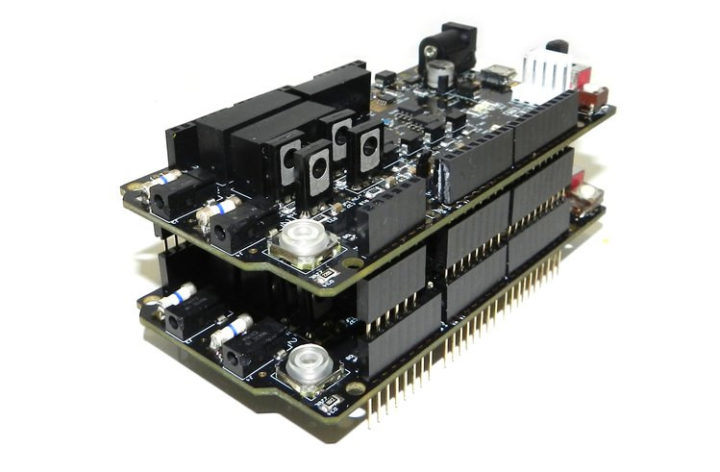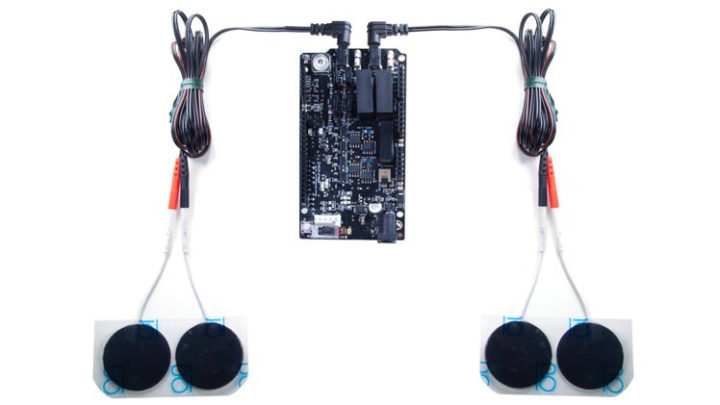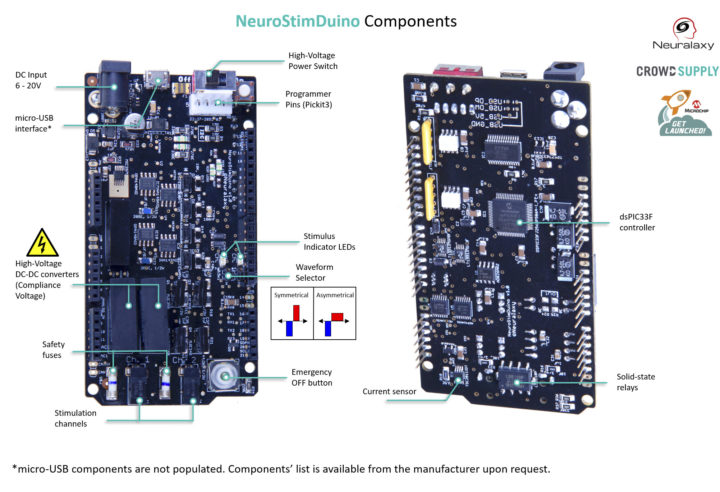Neuralaxy’s NeuroStimDuino is an open-source Arduino shield that allows students, researchers, and hobbyists to study the effects of neurostimulation on muscle contraction easily and cheaply.
What is Neurostimulation exactly? It works by applying short electrical pulses to the surface of the skin for the purpose of stimulating the underlying nerves and muscles. Neurostimulation has several uses including a treatment called Functional Electrical Stimulation (FES) therapy to help restore mobility in the paralyzed limb muscles of stroke victims and those who have suffered spinal cord injuries, and studies are being carried out to better understand how it can be leveraged for pain reduction and sensory feedback.

NeuroStimDuino hardware specifications:
- MCU – Microchip dsPIC33F 16-bit microcontroller (40 MIPS) with 256 KB flash memory
- Two independent 2mm output jack per board with:
- Adjustable current output range – +/- 25 mA, resolution 250 µA/step
- Adjustable stimulation frequency range – 1 – 100 Hz, pulse-width 0 – 2 ms
- Maximum compliance voltage – +/- 72 V
- Multiple boards are stackable for a maximum of 256 channels
- ADC – 12-bit DAC or external DAC to measure current output
- USB – Unpopulated micro USB port which could be used to control NeuroStimDuino from a PC over serial
- Misc – Onboard opto-isolators separate digital and analog signals, LEDs to indicate when stimulation is delivered, safety features (fuse, emergency OFF switch, etc…)
- Host interface – I2C with a programmable, 7-bit address.
- Power Supply – 9 V battery connected to a DC input or by an external 5 V input on VIN. 2x Li-Ion batteries (18650s) connected in series are recommended
- Compatible with Arduino Due and MEGA boards

The board generates biphasic, rectangular, and constant current stimulation pulses with programmable frequency, pulse-width, and amplitude, and an accessory kit includes four 1.25-inch round and four 2-inch square hydrogel electrodes, a pair of lead wires, and a pair of bifurcation cables to get started out of the box. While a single output channel on NeuroStimDuino can contract small muscles, the 25mA current delivered is insufficient for larger ones, and instead, the two output channels of NeuroStimDuino should be combined in parallel.
The EAGLE schematics and PCB layout files can be found on Github. There’s also a demo directly, but at the time of writing, it only contains a demo video and there’s no code at all. It should be noted that the shield is not FDA approved, and should only be used for evaluation or research.


Jean-Luc started CNX Software in 2010 as a part-time endeavor, before quitting his job as a software engineering manager, and starting to write daily news, and reviews full time later in 2011.
Support CNX Software! Donate via cryptocurrencies, become a Patron on Patreon, or purchase goods on Amazon or Aliexpress




